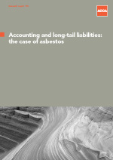Lee Moerman and van der Laan, March 2013. The interaction of the financial uncertainty arising from asbestos in a period of economic downturn provides an opportunity to explore corporate disclosures and issues of accountability and has the potential to inform standard-setting, social and environmental accounting and accounting for long-tail liabilities as well as corporate accounting issues associated with toxic products more generally. This report uses silent and shadow reporting to construct alternative accounting narratives of former asbestos mining and manufacturing companies in the Australian context and resonates with other jurisdictions facing similar issues in corporate reporting and accountability. (Ref: RR-130)

ACCA research report no. 130
Lee Moerman
School of Accounting and Finance, University of Wollongong
Sandra van der Laan
University of Sydney Business School. The University of Sydney
Long-tail liabilities arising from occupational and environmental exposure to toxic products from the mining and manufacturing industries creates a ‘manufactured uncertainty’ for corporations (Michaels and Monforton 2005). These toxic products include tobacco, beryllium, benzene, chromium, lead, pharmaceuticals and, importantly, asbestos. Asbestos provides a unique case of a long-tail liability because asbestosis and mesothelioma are both sequelae (pathological consequences) of asbestos exposure with long latency periods that exacerbate uncertainty about the timing and amount of workers’ compensation and product liability claims.
The increasing incidence of asbestos-related disease globally and the potential inadequacy of extant corporate reporting regimes to disclose asbestos-related corporate social responsibility information to stakeholders are under-researched. The increasing quantum and nature of claims require policymakers and regulators to provide appropriate mechanisms for reporting and ensuring appropriate provisioning for current and future asbestos claims. The asbestos case study provides a foundation for the development of accounting practices for long-tail liabilities from occupational and environmental exposure to toxic products more generally.
The aim of this research was to conduct a case study of the corporate disclosures relating to the uncertainty arising from long-tail liabilities, focusing on the asbestos industry in Australia. The interaction of financial uncertainty arising from asbestos liabilities with the consequences of a period of economic downturn provides a window for exploring corporate disclosures, both financial and narrative.


